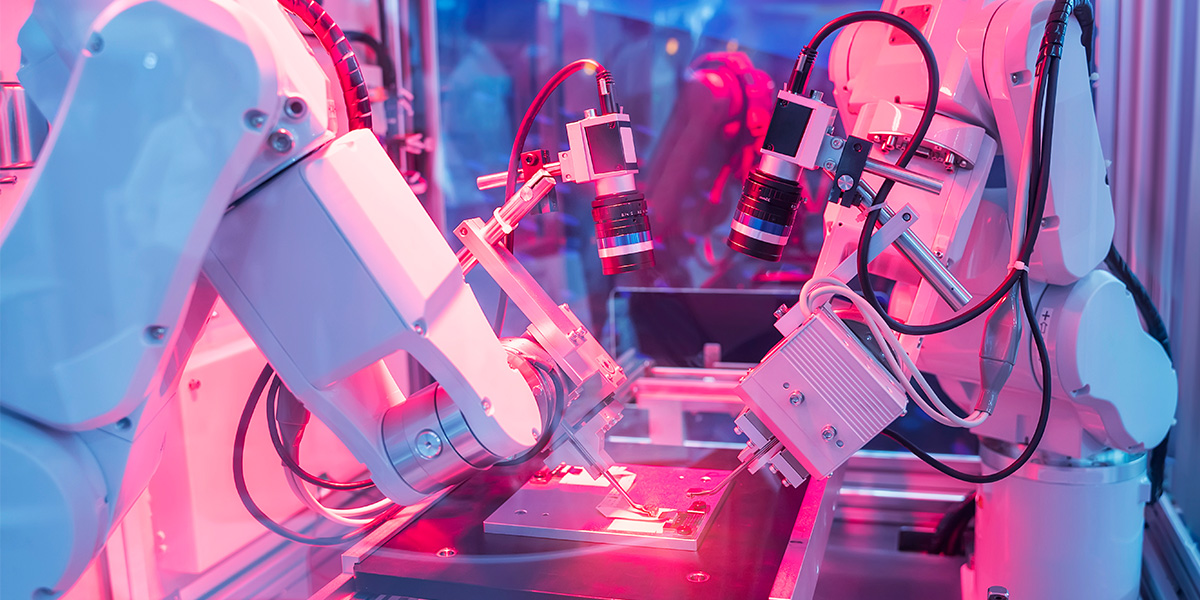- August 10, 2022
Machines Rising Slowly: Robot Adoption Hasn’t Kicked into High Gear…Yet
Humans have long had an uneasy relationship with the machines they create. From the Luddites smashing textile machines to Boston Dynamic’s dystopian robot dogs, we alternately embrace machines for productivity and spurn them as destroyers of jobs.
Fears of robots taking over human jobs have been around at least since the turn of the 20th century, but the debate has taken on urgency with the penetration of industrial robots in the last few decades. For instance, contrary to the predictions that automation would augment workers’ productivity, recent studies have found that it drove down both employment and wages in the US manufacturing sector.
Are robots finally here to eat workers’ lunch? So far, not so much. Robots’ anticipated progress has been more of a slow burn adoption across countries at varying speeds. In fact, the pace of adoption and its associated impact on manufacturing depends more on each country’s policy environment than just market forces alone.
In ten charts, we dive into why robots aren’t coming as quickly as expected, and why, in some cases, even targeted industrial policy is insufficient for accelerating robot adoption (see Figure 1).
Figure 1. Commercial Robot Installations Rose 600% Globally
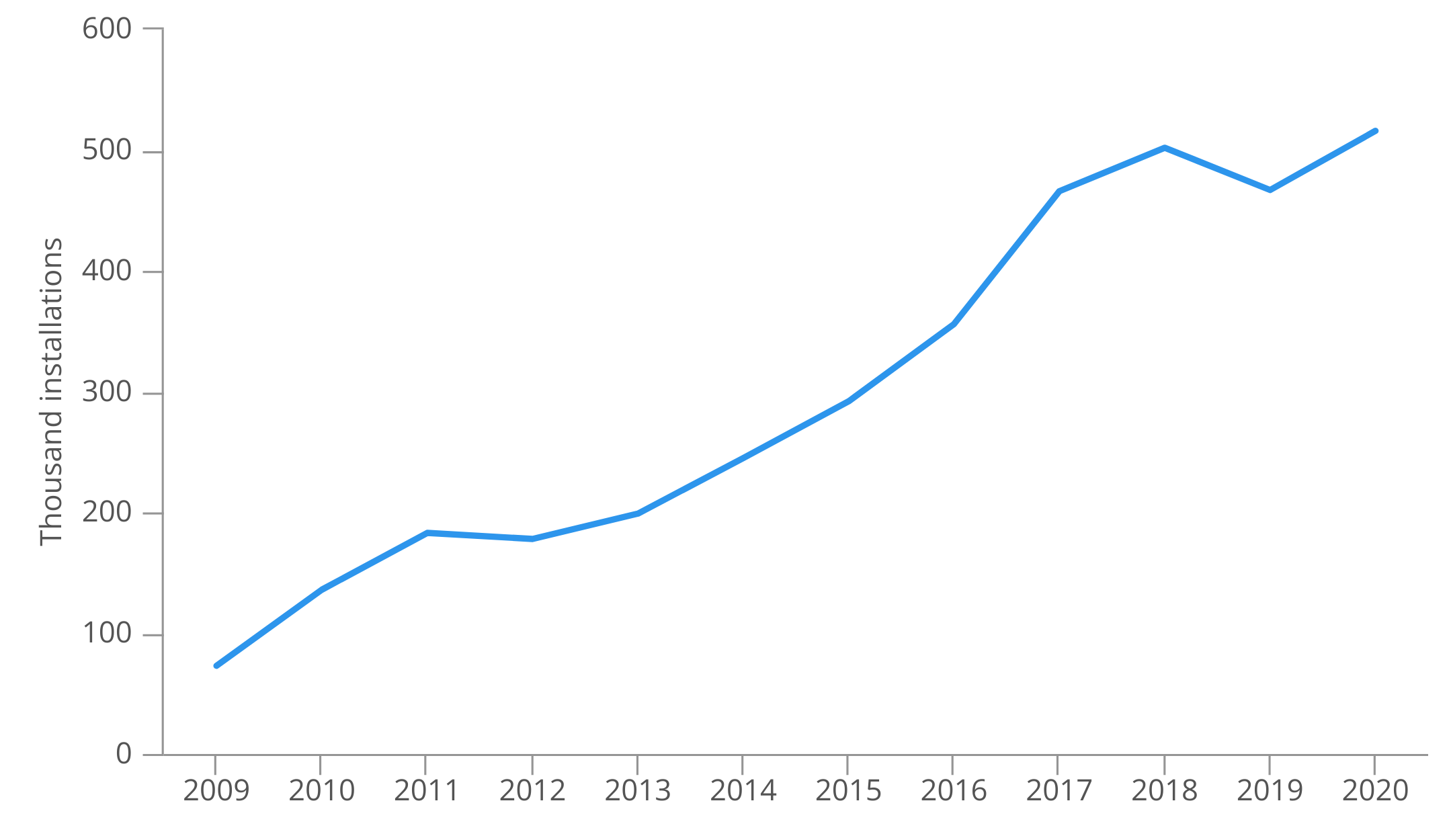
Source: International Federation of Robotics (IFR).
That massive growth is mainly a result of the low-base effect. When compared to industry’s appetite for information technology (IT) equipment, robot adoption looks much less impressive and is at least a decade behind (see Figure 2).
Figure 2. Robots Still a Fraction of Industry’s Investment in IT
 Source: E. Benmelech and M .Zator, Robots and Firm Investment, NBER Working Paper No. 29676.
Source: E. Benmelech and M .Zator, Robots and Firm Investment, NBER Working Paper No. 29676.
Although the manufacturing industry is most conducive to automation, not more than 60% of an average worker’s tasks may be automated, which partly explains the lag in robot adoption. Industrial robots are most suited for quotidian tasks that require physical force and precision. But a compound task—one even as simple as picking up goods from multiple workers in a warehouse—can be performed just as well by a good old conveyor belt.
Therefore, robot adoption tends to be concentrated in industries where manufacturing processes involve considerable rote tasks. That makes the auto and electronics production by far the biggest embracers of robots (see Figure 3).
Figure 3. Auto and Electronics Industries Make Up Nearly 60% of Total Robot Stock
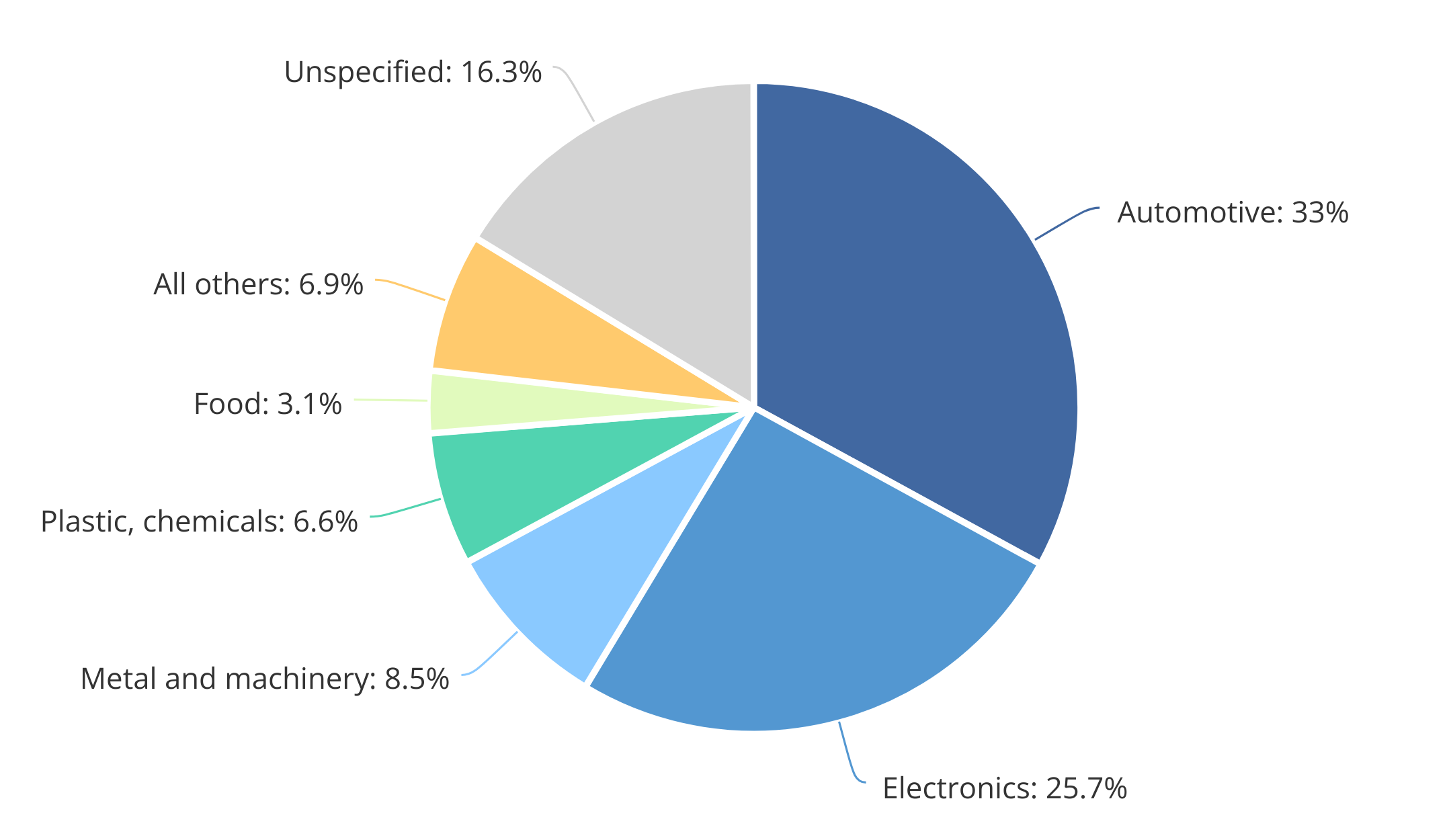
Note: Aggregate stock of industrial robots as of 2020.
Source: IFR; author calculations.
Now let’s turn to the reasons why countries adopt robots. It boils down to three main factors: wages and demographics, industry composition, and policy support.
Wages and demographics
Figure 4. Advanced Economies Lead the Way in Robot Adoption
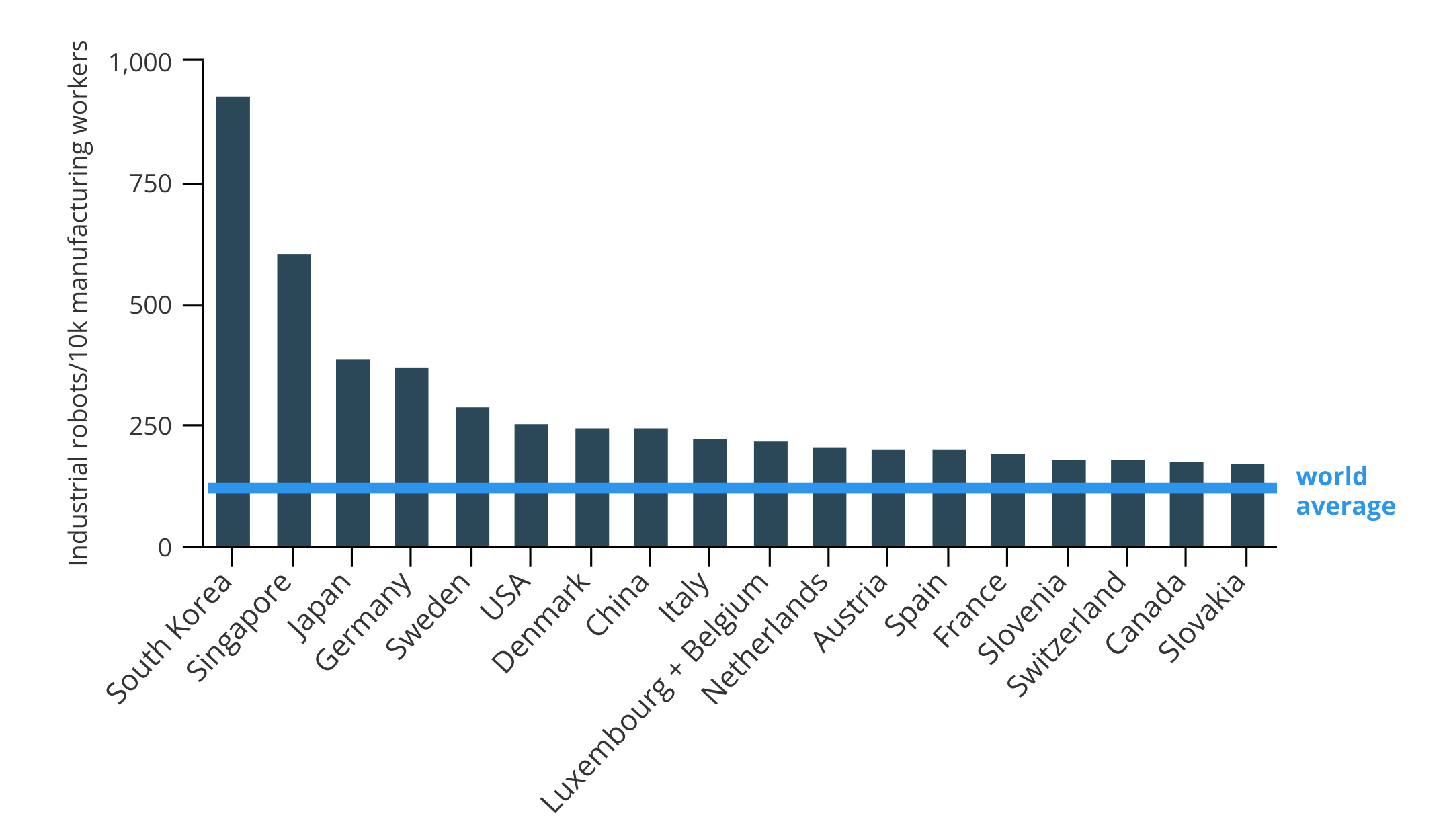
Source: IFR.
Robots are basically competing with wages. Although there are enormous variations in estimates depending on the robot’s functions, on average an industrial robot system replaces 3.3 workers. Assuming manufacturing wages of $10/hour, back-of-the-envelope estimate shows that investment in a robotic system would pay off within a year. Thus, it is perhaps not so surprising that advanced economies with higher wages have been the leaders in adoption (see Figure 4).
But what explains the notable delta between East Asian economies and other advanced economies? Mainly demographics.
Figure 5. Robotization of Industry Correlates with Demographic Transition
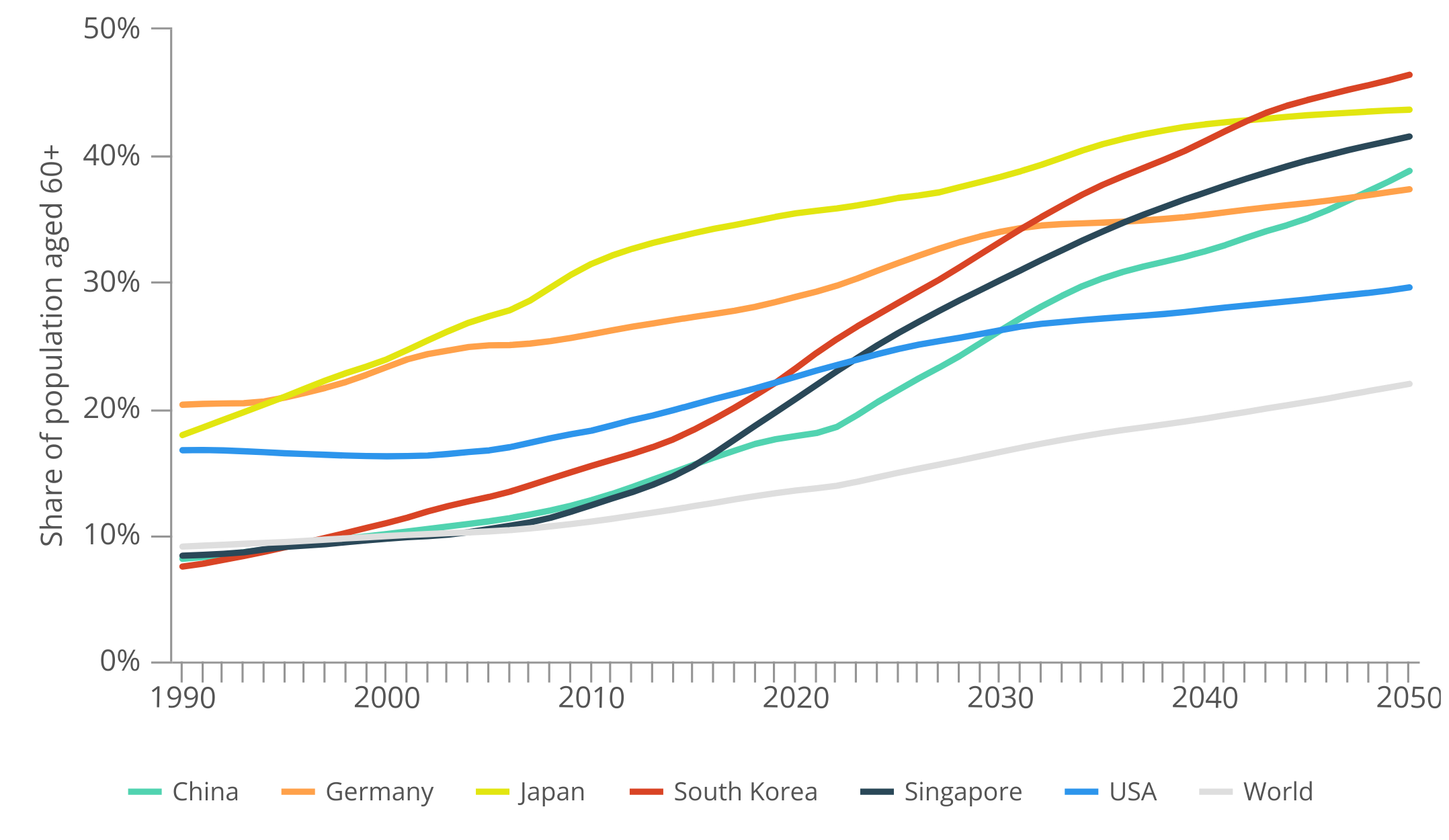 Source: UN DESA World Population Prospects 2022, medium variant.
Source: UN DESA World Population Prospects 2022, medium variant.
Take Japan, one of the oldest East Asian countries. It became an “early adopter” of industrial robots to mitigate labor shortages and upward wage pressures caused by the drying up of rural-urban migration in the 1980s and a rapidly aging population starting in the mid-1990s (see Figure 5).
Today, Japan has managed to become a global leader in robot adoption without significantly hurting jobs. In fact, for every 1% increase in robot adoption, Japan’s manufacturing employment was up 0.28%. The country also makes up 45% of industrial robot production and 32% of its exports globally, according to IFR and UN Comtrade.
Industry composition
Beyond demographics, what explains lower-wage countries adopting robots faster than they should? The industrial composition of an economy matters.
Figure 6. Some Countries Are Adopting Robots Faster Than They Should
 Note: The “optimal robot density” for each country is calculated based on average wages in its manufacturing sector, with the assumptions that a robotic system replaces 3.3 workers and global average ROI for each country. Then the actual robot density is compared to optimal robot density to derive a ratio for the country. Methodology adapted from “Which Nations Really Lead in Industrial Robot Adoption?“, 2018, ITIF.
Note: The “optimal robot density” for each country is calculated based on average wages in its manufacturing sector, with the assumptions that a robotic system replaces 3.3 workers and global average ROI for each country. Then the actual robot density is compared to optimal robot density to derive a ratio for the country. Methodology adapted from “Which Nations Really Lead in Industrial Robot Adoption?“, 2018, ITIF.
Source: IFR; International Labor Organization (ILO); author calculations.
Take Thailand, which has a huge automaking sector that serves foreign companies. Given that the auto industry is one of the most susceptible to robotization (see Figure 3 above), that offers a plausible explanation for why Thailand has a higher level of robotization than one might expect given its wage levels (see Figure 6).
Policy environment: support or obstacle
Figure 7. Robot Adoption in South Korean Auto Industry Lower Than in Peer Countries
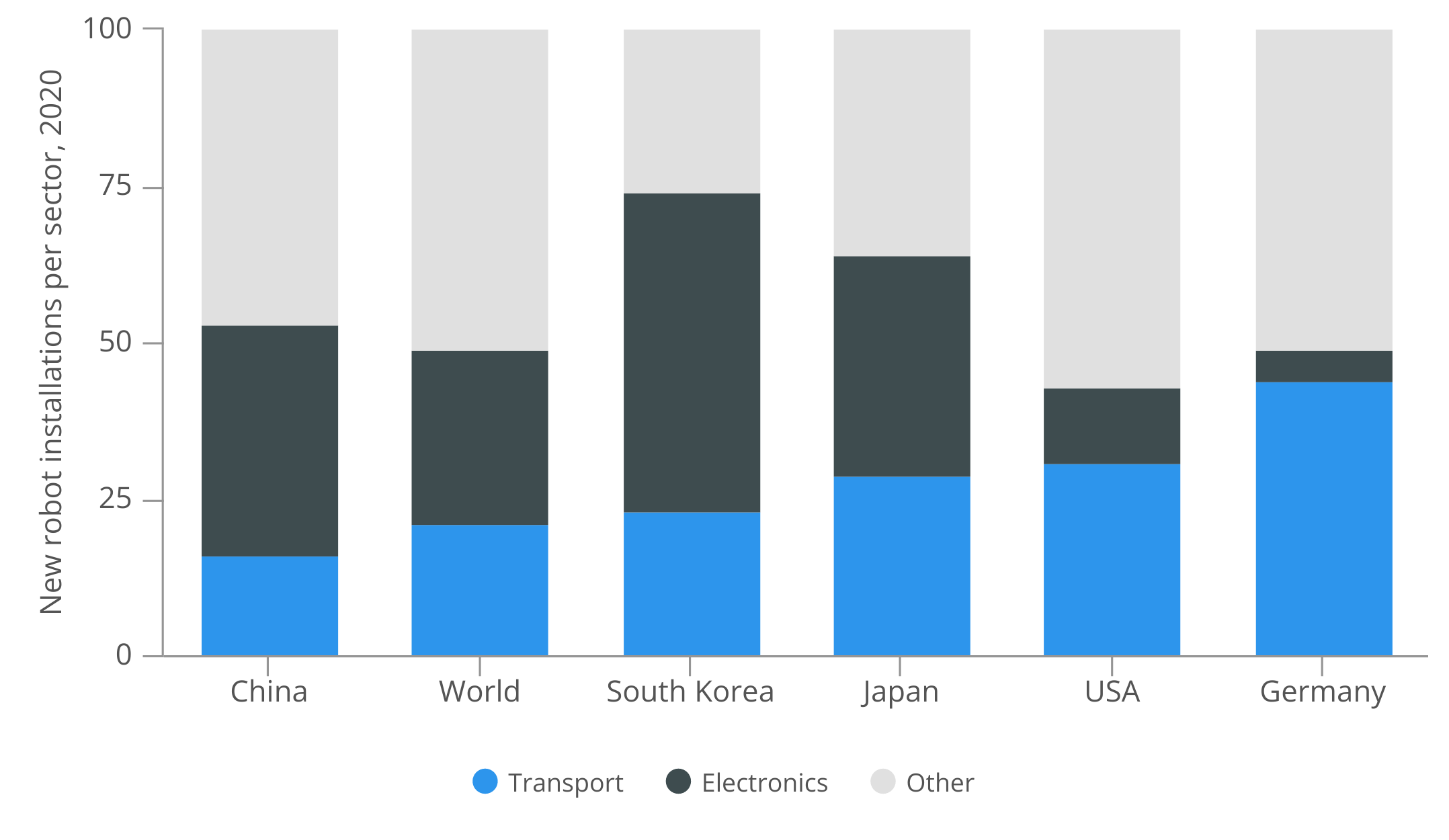
Source: IFR.
Not only are robots commonly found in the auto industry, so are labor unions. Take South Korea, which has the highest robot density globally and a sizable auto sector. Yet most of the country’s industrial robots are installed in the electronics industry (see Figure 7). That’s because the notorious strength of Korea’s labor unions served as a countervailing force against rapid automation of auto plants.
Labor unions are just one part of a broader policy environment that can either significantly disrupt labor markets or cushion the impact of automation, thus accelerating or halting the process.
Take Germany and the United States. The former has a higher robot adoption rate than the latter because Germany is older and has a formidable auto sector. Yet after two decades of robotization, Germany has seen no net effect on employment at the national level, even though manufacturing jobs have declined by 23%. In contrast, robot adoption in the United States has been slower but has led to net job losses nationally.
The contrast in outcomes can be in part explained by Germany’s responsiveness to the anticipated reduction in manufacturing jobs. Rather than laying off existing workers, German manufacturers halted new hiring and encouraged young people to start careers in the services sector.
In terms of existing workers, the high performers continued to get training and raises while average performers had to swallow pay cuts. This was possible under the forbearance of German labor unions that have a strong preference for maintaining high employment levels while tolerating wage declines.
US workers, on the other hand, have less tolerance for wage cuts and are more than four times as likely to quit over wages than their German peers. In the absence of comparable adjustment and reskilling mechanisms as in Germany, the United States has not coped as well on jobs.
What about China?
The eventual outcome and impact of automation likely lies with China, since it has all three factors needed for rapid robot adoption. It contains the world’s largest labor force that is also fast becoming one of its oldest (wage and demographics); it has an enormous manufacturing sector (industry composition); and it has an activist government pushing for doubling robot density by 2025 (policy environment).
Figure 8. Key Factors Contribute Differently to Pace of Robotization Across Countries
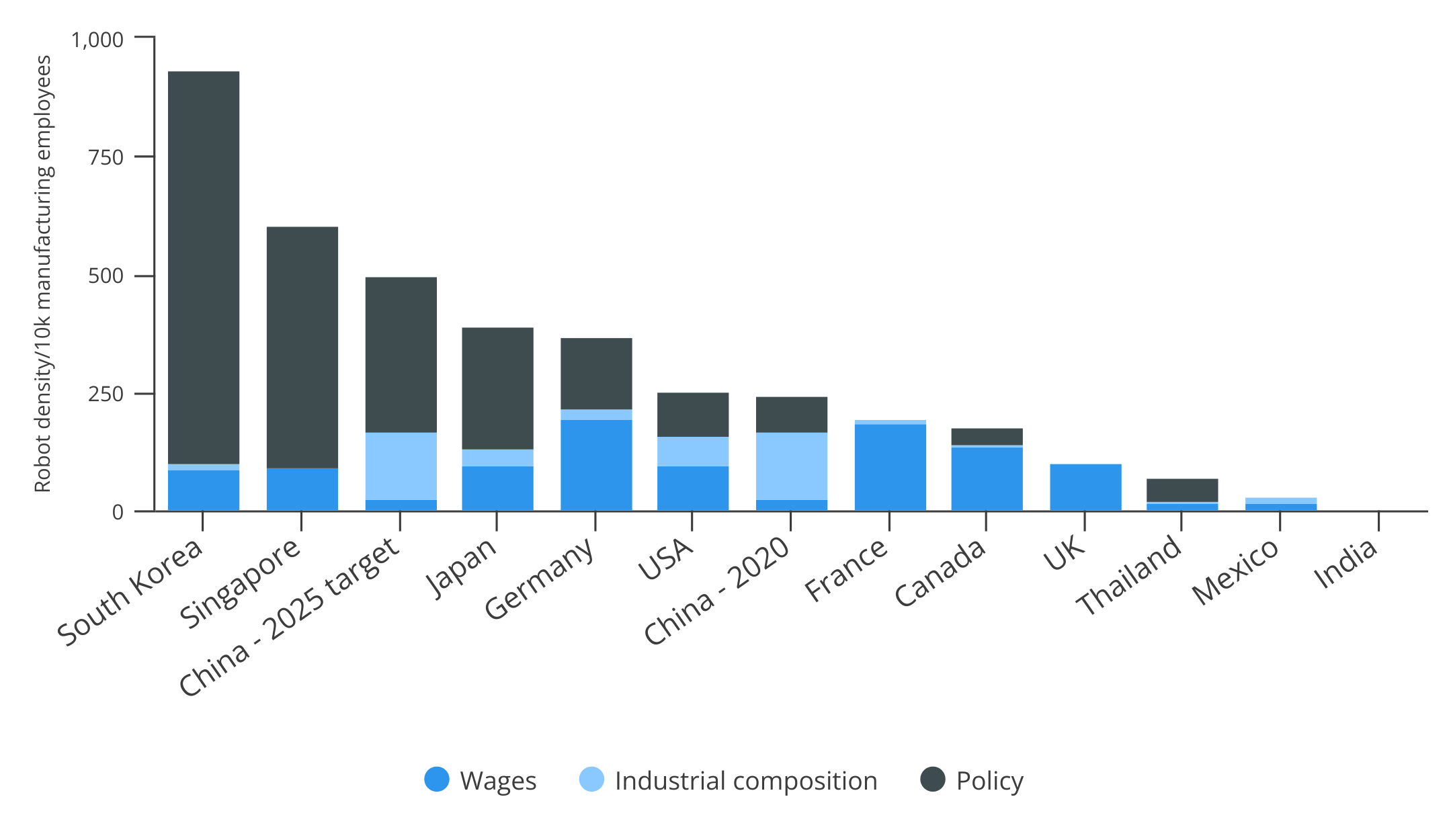 Note: Wages contribution calculated based on expected density (see methodology for Figure 6); industrial structure contribution is indexed after the electronics and car manufacturing output; policy contribution is calculated as a residual.
Note: Wages contribution calculated based on expected density (see methodology for Figure 6); industrial structure contribution is indexed after the electronics and car manufacturing output; policy contribution is calculated as a residual.
Source: IFR, ILO, United Nations Industrial Development Organization, International Organization of Motor Vehicle Manufacturers, author calculations.
A quick assessment of these factors implies that China could well look like a combination of Japan and Germany in terms of robotization (see Figure 8). The country’s demographic future is about as grim as Japan’s was, so it will likely need robots to stem labor shortages.
Figure 9. China Will Face a Shrinking Urban Labor Force in About a Decade
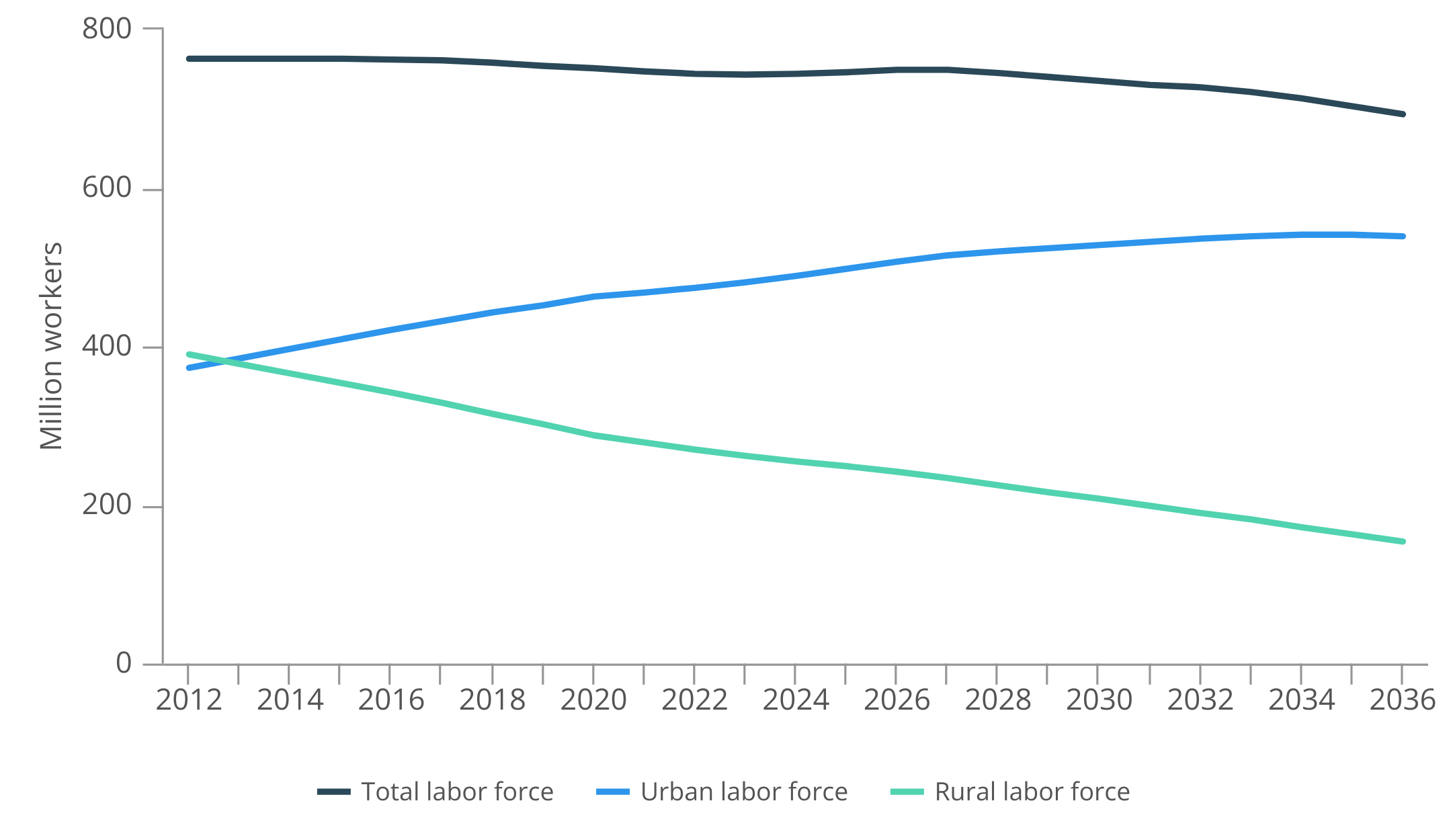
Source: Methodology adapted from “Global Demographics, China’s Labour Force Is, and Is Not, Growing!“, 2018.
Source: UN DESA World Population Prospects 2022, medium variant.
The country’s total labor force is expected to start declining after 2026, though continued internal migration should still mitigate some of the impact through 2035 (see Figure 9). By then, that rural-to-urban movement will be exhausted, which means robots will be desperately needed just to keep production at the same level.
In fact, China’s manufacturing sector is already experiencing labor shortages—it has had the largest number of unfilled vacancies for ten consecutive quarters since the pandemic. Many workers are apparently switching to readily available services jobs that are considered less exhausting.
These leading indicators, combined with notoriously weak labor unions, make the country’s conditions resemble that of Germany. If that’s the case, then China may not see a net job loss, instead tolerating wage cuts and shifting workers into the services sector.
Figure 10. China’s Productivity Per Worker Stagnates
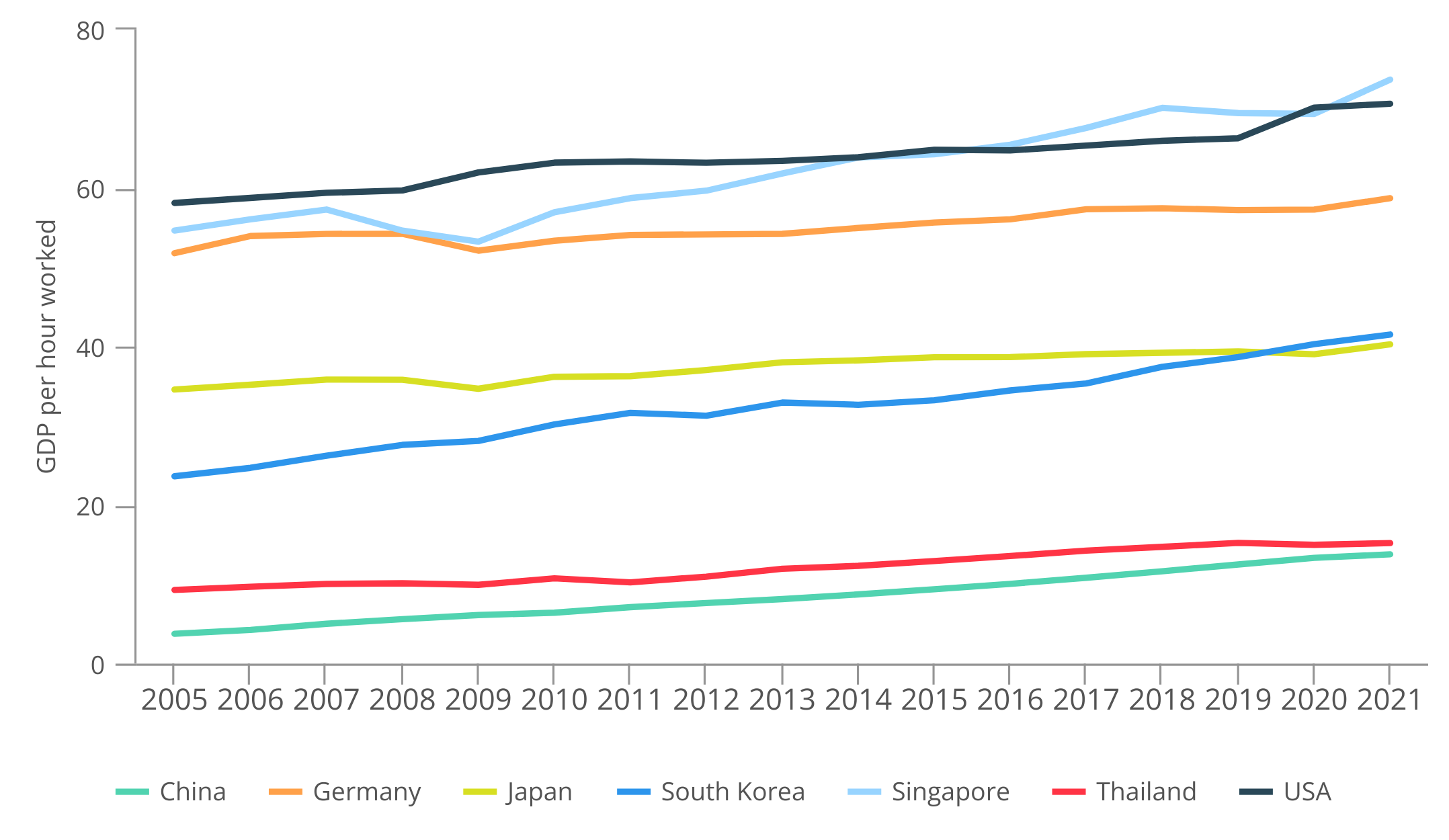
Note: GDP measured in constant 2017 USD in purchasing power parity.
Source: ILO.
Chinese manufacturing, however, still needs to figure out how to raise productivity and sustain growth for the next decade (see Figure 10). The solution to this puzzle seems to be increasingly about technology over humans. In this sense, robots are actually coming too slowly for China.
Rita Rudnik is a Summer Associate at MacroPolo.
Stay Updated with MacroPolo
Get on our mailing list to keep up with our analysis and new products.
Subscribe
